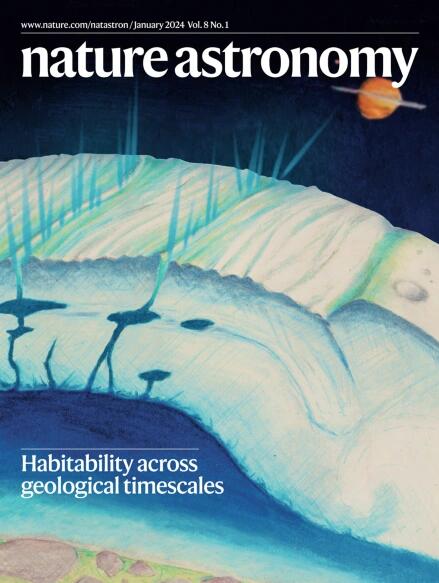在快速旋转的双星中增强的磁场活动
IF 14.3
1区 物理与天体物理
Q1 ASTRONOMY & ASTROPHYSICS
引用次数: 0
摘要
恒星活动是恒星演化、系外行星形成和宜居性的基础。磁表面活动是由低温恒星的对流运动和旋转之间的相互作用驱动的,从而产生一个发电机过程。在单星中,活动随着旋转速率的增加而增加,直到旋转周期为3-10 d的恒星达到饱和。然而,导致饱和的机制尚不清楚。观测表明,双星系统中处于自旋轨道共振的红巨星比具有相似旋转速率的单星表现出更强的色球活动,这表明潮汐流可以影响表面活动。本文研究了主序双星的色球活动,以了解潮汐力对饱和现象的影响。对于具有0.5 < Prot (d) <; 1的双星,主要是具有共同热包络的接触式双星,我们发现活性增强而不是饱和度。这一结果支持了在共包络演化过程中大规模α -ω发电机可以产生强磁场的理论预测。我们还观察到色球活动的过饱和,这是一种先前在日冕活动中初步注意到的现象,在日冕活动中,活动水平低于饱和,并且随着旋转周期的缩短而减少。我们的发现强调了研究与太阳相比具有极端特性的恒星的恒星活动的重要性。本文章由计算机程序翻译,如有差异,请以英文原文为准。


Enhanced magnetic activity in rapidly rotating binary stars
Stellar activity is fundamental to stellar evolution and the formation and habitability of exoplanets. Magnetic surface activity is driven by the interaction between convective motions and rotation in cool stars, resulting in a dynamo process. In single stars, activity increases with rotation rate until it saturates for stars with rotation periods Prot < 3–10 d. However, the mechanism responsible for saturation remains unclear. Observations indicate that red giants in binary systems that are in spin–orbit resonance exhibit stronger chromospheric activity than single stars with similar rotation rates, suggesting that tidal flows can influence surface activity. Here, we investigate the chromospheric activity of main-sequence binary stars to understand the impact of tidal forces on saturation phenomena. For binaries with 0.5 < Prot (d) < 1, mainly contact binaries that share a common thermal envelope, we find enhanced activity rather than saturation. This result supports theoretical predictions that a large-scale α–ω dynamo during common-envelope evolution can generate strong magnetic fields. We also observe supersaturation in chromospheric activity, a phenomenon tentatively noted previously in coronal activity, where activity levels fall below saturation and decrease with shorter rotation periods. Our findings emphasize the importance of studying stellar activity in stars with extreme properties compared with the Sun’s. Binary stars with orbital periods of less than a day show magnetic activity beyond the saturation limit of single stars. This enhanced activity is probably driven by a large-scale α–ω dynamo during common-envelope evolution.
求助全文
通过发布文献求助,成功后即可免费获取论文全文。
去求助
来源期刊

Nature Astronomy
Physics and Astronomy-Astronomy and Astrophysics
CiteScore
19.50
自引率
2.80%
发文量
252
期刊介绍:
Nature Astronomy, the oldest science, has played a significant role in the history of Nature. Throughout the years, pioneering discoveries such as the first quasar, exoplanet, and understanding of spiral nebulae have been reported in the journal. With the introduction of Nature Astronomy, the field now receives expanded coverage, welcoming research in astronomy, astrophysics, and planetary science. The primary objective is to encourage closer collaboration among researchers in these related areas.
Similar to other journals under the Nature brand, Nature Astronomy boasts a devoted team of professional editors, ensuring fairness and rigorous peer-review processes. The journal maintains high standards in copy-editing and production, ensuring timely publication and editorial independence.
In addition to original research, Nature Astronomy publishes a wide range of content, including Comments, Reviews, News and Views, Features, and Correspondence. This diverse collection covers various disciplines within astronomy and includes contributions from a diverse range of voices.
 求助内容:
求助内容: 应助结果提醒方式:
应助结果提醒方式:


